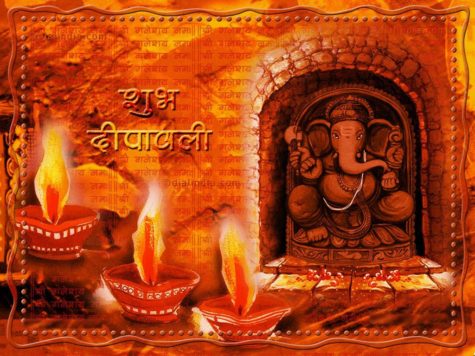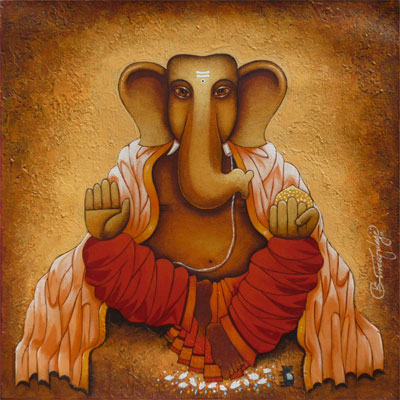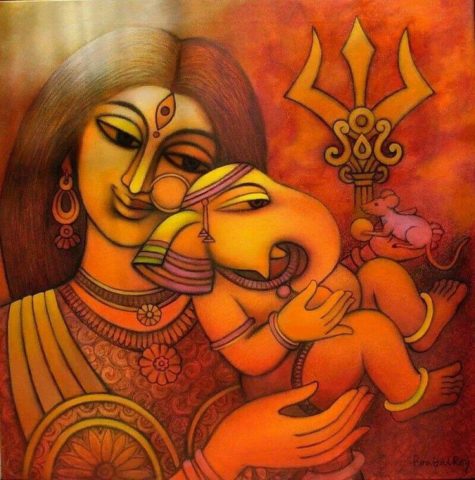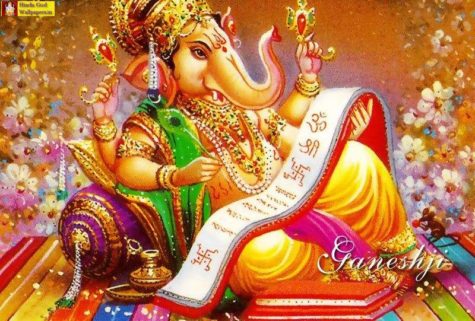Daily Archives: September 11, 2018
Ganesh Maha Mantra
This video is a humble offering at the feet of our Lord Ganesh.
Ganesh Maha Mantra:
Om Gam Ganapataye Namaha
Ganesha mantras are siddhi mantras. Each mantra contains certain specific powers of Lord Ganesha. When chanted with the proper pranayama (rhythmic breathing) and sincere devotion, they will yield good results. In general, Ganesha mantras will ward off all evil and bless the devotee with abundance, prudence and success. Evil spirits dare not enter the home or the mind of the devotee where Ganesha mantras are recited.
- Album – Sacred Morning Chants – Shri Ganesh
- Artist – Shankar Mahadevan
A Hymn To Ganesha
A Renowned Five-Jeweled Hymn by
Sri Adi Sankara (798-820)
Free-Flowing Translation by J. Sethuraman
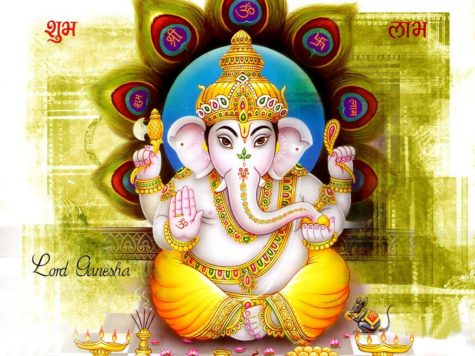
Maha Ganesa Pancharatna Stotram
I bow to Vinayaka
Who, with glee, holds a half-eaten modaka in His hand,
Who is the ever-present means of moksha
Who has the moon as an ear ornament,
Who protects all the worlds,
Who is the single leader for those who are lost without anybody to help them,
Who destroyed the elephant demon and
Who swiftly removes the blemishes of those who bow to Him.
I seek refuge of the great Lord Vinayaka
Who is higher than the highest,
Who is everlasting,
Who is ferocious to others than those that bow to Him,
Who is resplendent as the newly rising sun,
Worshiped by both demons and Gods,
The savior of those that bow to Him from all their miseries,
The lord of all the Gods,
The lord of all wealth,
The elephant God,
And Ganesvara, the lord of the ganas.
I bow to the resplendent one
Who bestows peace to all the worlds,
Who conquered the elephant demon,
Who has not a small belly,
The excellent one,
Who has a beautiful elephant face,
Who is eternal,
Who is kind,
Who is forgiving,
Who gives happiness,
Who bestows fame and
Who satisfies every wish of those that bow to him.
I worship the ancient elephant God
who shares the misery of the poor,
the fit receptacle of all the ancient prayers,
the first son of the enemy of the three cities (Shiva),
the shatterer of the pride of the demons,
the fierce destroyer of the worlds,
decorated by fire and other elements, and
whose elephant cheeks are flowing with must
(the rut that flows from the cheeks of male elephants.)
I constantly think of Him alone,
the single-tusked one,
With a lovingly brilliant tusk,
The son of the destroyer of the sacrifice (Shiva),
With a form that cannot be comprehended,
With no end,
Who tears asunder all doubts, and
Who is verily like spring to the yogis who hold Him in their hearts all the time.
One who repeats every day
The Maha Ganesha Pancharatna Stotram
With reverence
In the mornings or evenings
while holding Ganesvara in his heart
He, very quickly,
Will be joined by
Good health, blemishlessness, good fellowship, good children, long life,
and the eight vibhutis (powers).
from Loving Ganesa
by Satguru Sivaya Subramuniyaswami
How To Meditate
For the purpose of this project, we are recommending the “unstructured” meditation practice. In the “unstructured” meditation practice, we simply substitute the mantra for our normal mental chatter.
Whenever you feel angry, uncomfortable, unhappy, frustrated, upset, scared, bored, unsure, or unloved, simply begin to think (or say) the mantra. If you notice that you are dwelling on unpleasant experiences in the past, experiencing unhappiness in the present present or envisioning a disastrous future – just go back to thinking the mantra. Any time you find yourself in the grip of worry, guilt, or fear – this just means it’s time to begin thinking the mantra again. When you are driving in your car, when you are cleaning your house, when you are working out, when you begin a new task – these are all excellent times to remember the mantra.
Eventually, the mantra will be a constantly running stream in the background of your mind. Your “worry” thoughts will begin to take on less importance. It’s as if, when you wake up in the morning, you begin your meditation practice, and you continue it all day long until you go to bed. Anytime you notice “Oh, I am not thinking that mantra,” just begin it again.
The mantra may be said aloud, or sung, or chanted, or allowed to just run silently through your mind. It doesn’t matter at all. Whatever feels most comfortable for you at the time.
If you prefer a more structured practice, that’s fine too. Here are some guidelines you might find helpful:
Traditional meditation practice is called Japa, or recitation, and is the spiritual practice of devotedly repeating a mantra, generally a specified number of times, such as 108, often while counting on a strand of beads, called a japa mala, while conscientiously concentrating on the meaning of the mantra. The mantra can also be repeated for a specified period of time, such as 20 minutes. This can be done while sitting or walking, and gives the best results with a consistent daily practice.
The repetition should be dutifully slow. This brings punya, merit, to the devotee. Japa is a form of devotional worship, invocation, supplication, praise, adoration, meditation and direct, experiential communion.
Unless we are actually in a state of samadhi (total absorption), which is rare for most people, japa provides a means to disengage from our racing thoughts and our memories of the past — mostly the bad ones. The repetition of positive, uplifting, spiritual mantras over and over again lifts consciousness and causes the muladhara chakra to spin clockwise. We feel uplifted. Life does not look so bad, and neither does the past. A sense of forgiveness comes and the future looms bright. The past is forgiven and forgotten. Japam can be done by everyone.
Making A Shrine For Ganesh

Creating a home shrine is not difficult. The altar should be close to the floor if you plan to use it for puja and/or meditation. However when there are small children in the home it is often best to have it higher and out of reach.
For a Ganesha shrine, an image, or murti, of Lord Ganesha is placed at the center of the altar. A metal or stone image is best, but if not available there are two traditional alternatives:
- A framed picture, preferably with a sheet of copper on the back.
- A kumbha, which is a symbol of Ganesha made by placing a coconut on a brass pot of water with five mango leaves inserted between the coconut and the pot. The coconut should be husked but still have the fibers on the top.
Bathing the God’s image (murti) is a part of a puja and other ceremonies. For this, special arrangements may need to be made. Most simply, the murti may be placed in a deep tray to catch the water. After the bath, the tray is removed and the murti dried off, and then dressed and decorated.
Various items for the altar can include:
- Water cups and a small spoon for offering water
- A brass vessel of unbroken, uncooked rice mixed with enough turmeric to turn the rice yellow
- A tray or basket of freshly picked flowers (without stems) or loose flower petals
- A lamp
- Small metal bell
- Incense burner and a few sticks of incense
- Fresh fruit
Removing Obstacles using the Ganesh Mantra
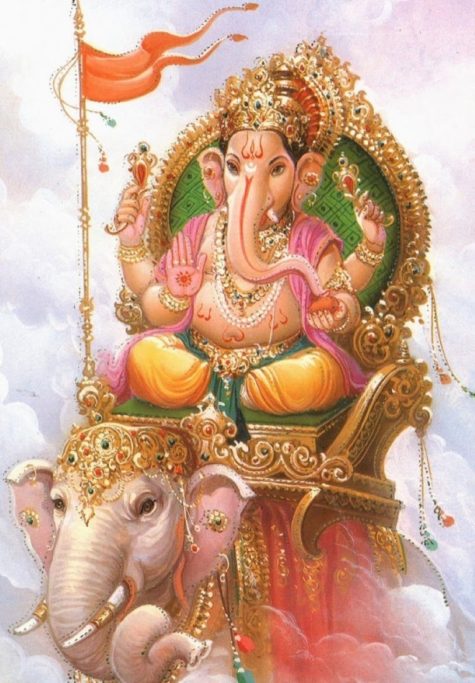
Do you have problems in your life? Have you been encountering obstacles, trials, tribulations? Are you at the beginning of a business venture, working on a book, taking classes, or planning a trip? Do you need a little extra help from unexpected sources? If the answer to any one of these questions is “yes”, then you might want to consider joining us this month.
It’s easy, it costs nothing, and it takes very little time out of your busy schedule. It might even lighten your load. You may find that your projects and tasks flow more easily, that your income increases even as your work load decreases. It just might be the best thing you ever did for yourself. All that is required is a commitment to try it for 30 days, and to share your experiences (positive or otherwise) with the other members of the project.
How does it work?
The post with the mantra, will be uploaded tomorrow (Feb 7th) which is the “official” start of our 30 days. I have collected lots of nifty and interesting tidbits of information, and other cool stuff which will be uploaded as our 30 days progresses. I am really hoping that we can generate some lively discussion, and give each other support as we work this project.
Note:
This is the original post from 2007. The information on the mantra has already been uploaded and can be found in the post about Revisiting Ganesh.
Who is Ganesh?
Ganesha is India’s cutest god. He has the head of an elephant on which is perched a dainty tiara, four pudgy hands joined to a sizeable belly with each hand holding its own symbolic object. One has a trishul, or a trident, the second, an ankush, or goad made from his very own broken tooth, the third hand elegantly holds a lotus and the fourth a rosary (which is sometimes replaced by modaks – his favourite sweet). His appetite for sweets is legendary and offerings of them are often left at his shrine.
Ganesha is famous not only for being a trickster and for his sense of humour, but equally for his wisdom. He is the son of Shiva (Destroyer in the Hindu Holy Trinity of Creator-Preserver-Destroyer) and Parvati (Shiva’s consort).
The chubby, gentle, wise, elephant-headed Ganesh, or Ganesha, is one of Hinduisms most popular deities. He is the remover of obstacles, the deity whom worshippers first acknowledge when they visit a temple. He is also patron of letters and of learning; he is the legendary scribe who, using his broken tusk, which he often holds, wrote down parts of the Mahabharata epic.
From Loving Ganesa
by Satguru Sivaya Subramuniyaswami
Revisiting Ganesha
For the next 30 days, we will be revisiting the Invoking Ganesh project from 2007. This was one of my all time favorites. It always seems to work for me ~ when I remember to use it.
From Mind Valley, here are 6 benefits to a regular practice of chanting the Ganesh Mantra. I’m sure there are many more.
- The Ganesh mantra is known to activate the mind and various chakras of the body. This leads to better blood circulation and therefore improved metabolic rate in the body.
- It is said that it is best to chant the Ganesh Mantra before undertaking a new venture, as he is the bringer of success, prosperity, and good luck.
- Chanting the Ganesh Mantra also brings peace, or more literally – it removes all enemies from one’s path.
- It helps us focus.
- It brings clarity into our lives
- It is also said that if you chant the Ganesh Mantra 1008 times, it will remove fear from your heart.
What is the Ganesh mantra?
Well, actually there are a number of different Ganesh Mantras. The one we used for our original project was this one: Om Gam Ganapataye Namaha.
A loose translation might be:
- Om = The sound of the universe
- Gam = The secret power sound of Ganesh. It is his “seed syllable” or bija mantra.
- Ganapataye = Another name of Ganesh, the remover of obstacles.
- Namaha = I submit to a higher power.
The pronunciation is also pretty easy:
- Om = ohm or aum
- Gam = Somewhere between “gahm” and “gum”. In some dialects it is “guhng”.
- Ganapataye = gah-nah-paht-ah-yeh
- Namaha – nah-mah-hah
Repetition of this mantra over and over again brings peace, and is designed to help remove anything that might be blocking your progress. Some of us used the whole mantra, and some of us just used the bija or seed sound for the Ganesh Mantra, which is “Gam” and sounds like “gum.”
The mantra can be chanted aloud, or silently, or a combination of the two. You might want to do this as a regular meditation practice, or you can simply chant the mantra while on your way to work, whenever anything comes up that feels overwhelming, if you find yourself in a whirlpool of anxious thoughts, while walking, jogging, or even when falling asleep at night.
- Radical Self Care Project Overview by shirleytwofeathers - No Comment
- Radical Self Care Image Gallery by shirleytwofeathers - No Comment
- It’s A Wrap by shirleytwofeathers - 3 Comments
- Something To Consider by shirleytwofeathers - 1 Comment
- Nurturing Your Precious Self by shirleytwofeathers - 3 Comments
me: Make Your Own Violet Fire
Abdulrahman: Money Chant – Very Fast
Shirley Twofeathers: It’s A Wrap
Daniel Knirs: It’s A Wrap
Shirley Twofeathers: It’s A Wrap
